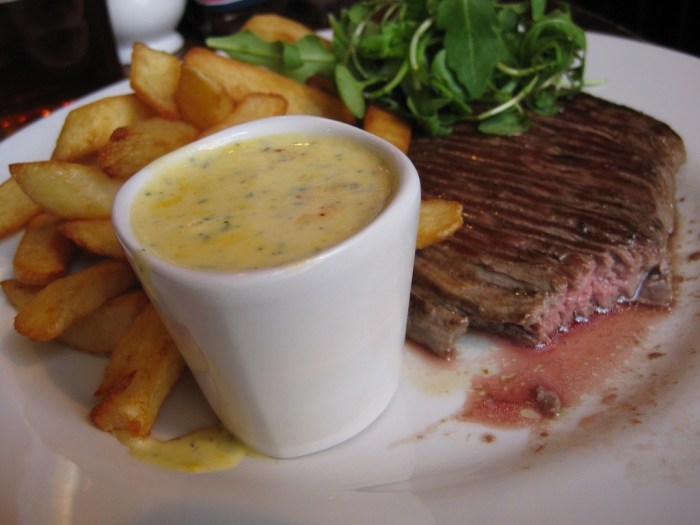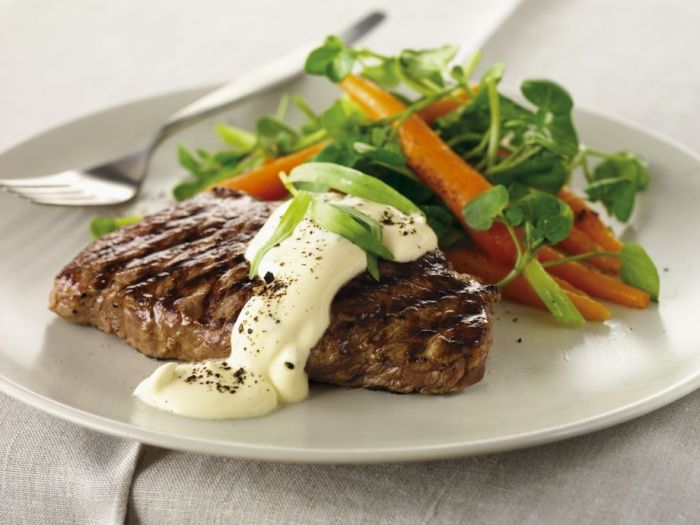Bearnaise Sauce: A Classic Companion to Steak: Bearnaise Sauce Recipe For Steak
Bearnaise sauce recipe for steak – Bearnaise sauce, a rich and decadent emulsion, elevates a simple steak to a culinary masterpiece. Its origins trace back to the 19th century, evolving from the classic hollandaise sauce. This article delves into the history, preparation, variations, and serving suggestions for this iconic sauce, ensuring even novice cooks can achieve perfect results.
Origins and Flavor Profile of Bearnaise Sauce
Bearnaise sauce, a cornerstone of French cuisine, is believed to have originated in the 1800s. While its exact creation is shrouded in some mystery, it’s widely accepted as a derivative of hollandaise, enhanced with the vibrant, herbaceous notes of tarragon. The classic flavor profile is characterized by a rich, buttery base, balanced by the sharp tang of vinegar and the aromatic complexity of tarragon.
A hint of shallot adds a subtle sweetness and depth, creating a harmonious blend of flavors.
Traditional Bearnaise Sauce Ingredients
The traditional recipe relies on a small number of high-quality ingredients, each playing a crucial role in achieving the desired texture and taste. These essential components ensure the sauce’s characteristic richness and complexity.
- Clarified butter: Provides a rich, flavorful base without the risk of curdling.
- Shallots: Contribute a subtle sweetness and savory depth.
- White wine vinegar: Adds a touch of acidity to balance the richness.
- Fresh tarragon: The star ingredient, providing its signature herbaceous and slightly anise-like flavor.
- Egg yolks: Act as an emulsifier, binding the butter and vinegar into a smooth, creamy sauce.
Classic Bearnaise Sauce Recipe
This recipe is designed for beginner cooks, emphasizing clear instructions and precise measurements. Follow these steps carefully to achieve a perfect Bearnaise sauce every time.
A classic bearnaise sauce elevates a simple steak to a gourmet experience. While completely different in flavor profile, the creamy richness of bearnaise shares a similar role to a luscious sauce like the one found in a barilla alfredo sauce recipe , both adding depth and indulgence to their respective dishes. Ultimately, the best sauce depends on personal preference, but a well-made bearnaise is undeniably a triumph.
- Finely chop 2 shallots. Melt 1 cup (2 sticks) clarified butter in a saucepan over low heat.
- In a heatproof bowl, whisk together 4 large egg yolks and 1 tablespoon white wine vinegar.
- Place the bowl over a simmering pot of water (double boiler), ensuring the bottom of the bowl doesn’t touch the water.
- Whisk constantly until the mixture thickens and becomes light and pale yellow.
- Slowly drizzle in the melted clarified butter, whisking continuously to create an emulsion.
- Remove from heat and stir in 2 tablespoons finely chopped fresh tarragon. Season with salt and freshly ground black pepper to taste.
- Keep warm until ready to serve.
Bearnaise Sauce Variations
While the classic recipe is undeniably delicious, exploring variations can broaden your culinary horizons. These variations offer unique flavor profiles while maintaining the sauce’s creamy texture.
- Bearnaise with a hint of lemon: Adding a teaspoon of lemon juice brightens the flavor profile, offering a refreshing counterpoint to the richness of the butter and tarragon. The lemon’s acidity enhances the overall taste.
- Spicy Bearnaise: Incorporating a pinch of cayenne pepper or a few drops of your favorite hot sauce adds a delightful kick. This variation appeals to those who enjoy a little heat with their steak.
- Mushroom Bearnaise: Sautéed mushrooms, finely chopped, can be added to the sauce after the butter is incorporated. The earthy notes of the mushrooms complement the tarragon beautifully, adding depth and complexity.
Serving Suggestions for Bearnaise Sauce and Steak

Source: foodrepublic.com
The right steak cut and cooking method significantly impact the overall dining experience. Pairing the right Bearnaise variation enhances the flavors further.
| Steak Cut | Cooking Method | Bearnaise Sauce Variation | Serving Notes |
|---|---|---|---|
| Filet Mignon | Pan-Seared | Classic Bearnaise | Serve immediately after searing, allowing the sauce to coat the tender meat. |
| Ribeye | Grilled | Spicy Bearnaise | The richness of the ribeye complements the spicy kick, creating a bold flavor combination. |
| New York Strip | Broiled | Bearnaise with Lemon | The bright lemon notes cut through the richness of the strip, balancing the flavors perfectly. |
Troubleshooting Common Bearnaise Sauce Problems

Source: eatsmarter.com
Even experienced cooks encounter challenges. Understanding potential issues and their solutions ensures success.
- Curdling: This usually occurs due to overheating or adding the butter too quickly. Prevent this by using a double boiler and whisking continuously, ensuring a gradual addition of the butter.
- Too thin: If the sauce is too thin, it likely needs more clarified butter. Add a tablespoon at a time, whisking continuously until the desired consistency is reached.
- Too thick: If the sauce is too thick, a teaspoon of warm water can help thin it out. Add gradually while whisking until the desired consistency is achieved.
Visual Guide to Bearnaise Sauce Consistency, Bearnaise sauce recipe for steak
The ideal consistency is smooth, creamy, and velvety, coating the back of a spoon. Visual cues help gauge the perfect texture.
- Too thin: The sauce will be runny and watery, lacking the desired richness. It will easily slide off the spoon.
- Too thick: The sauce will be stiff and clumpy, difficult to pour and spread. It will hold its shape on the spoon.
- Ideal: The sauce will be thick enough to coat the back of a spoon but still pourable. It will create a smooth, even layer when spread.
Make-Ahead and Storage Tips
Planning ahead saves time and stress. Proper storage maintains quality and freshness.
- Make-ahead: Bearnaise can be made up to a day in advance. Store it in an airtight container in the refrigerator.
- Storage: Refrigerate leftover sauce in an airtight container for up to 3 days.
- Reheating: Gently reheat over low heat, whisking constantly to prevent curdling. Avoid boiling.
Nutritional Information and Health Considerations
While delicious, Bearnaise sauce is high in fat and cholesterol. Moderate consumption is key. Consider healthier alternatives for regular use.
Note: Nutritional information is an approximation and can vary based on specific ingredients and measurements.
- Approximate Nutritional Information (per serving): Calories: 250-300, Fat: 25-30g, Cholesterol: 150-200mg.
- Healthier Alternatives: Consider using a reduced-fat butter substitute or incorporating more vegetables to increase the nutritional value.
Key Questions Answered
Can I make bearnaise sauce ahead of time?
Yes, bearnaise can be made a day ahead. Store it properly refrigerated and reheat gently before serving, avoiding high heat which can cause separation.
What happens if my bearnaise curdles?
Curdling usually indicates too much heat or improper emulsification. Try whisking in a tablespoon of very cold water or a small amount of melted butter, slowly and steadily.
What are some good substitutes for tarragon?
While tarragon is key, you can experiment with chervil or a combination of parsley and chives for a slightly different, but still delicious, flavor profile.
What type of vinegar is best?
White wine vinegar is traditional, offering a subtle acidity that balances the richness of the butter and egg yolks. You can experiment with other vinegars but use them sparingly.
